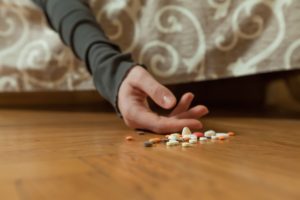
Drug overdose deaths have risen across the United States in recent years. In 2018, more people between the ages of 18 – 25 are dying from drug overdoses, but drug abuse rates amongst young teens are down. While the U.S. has done an excellent job of decreasing teen rates of drug addiction and abuse, young adults haven’t fared as well.
The most significant increase in drug overdose rates is attributed to heroin and prescription opioids. These drugs have become more powerful and widespread in recent years. The opioid epidemic has hit Appalachia and the eastern seaboard the hardest.

Since the 1990s, youth abuse, addiction, and overdoses of illegal amphetamines and stimulants have gone down, while heroin and opioid-related incidences of overdose have risen dramatically. In the early 2000s, the U.S. experienced a marked increase in doctors and physicians prescribing prescription painkillers to patients. These drugs were relatively new on the market and their risks unknown. People became addicted, and when their supplies of legal prescriptions ran out, many turned to illegal opioid derivatives and heroin. Since then, rates of heroin addiction have skyrocketed, and youths are paying the price.
The following article will cover the rates of drug abuse and overdose amongst youths across the U.S., and which drugs are more likely to be abused and why.
How do drug overdoses happen?
Drug overdoses can be intentional or accidental. Most drug overdose deaths are ruled accidental. People can overdose on drugs as a form of suicide, and in some cases, people will poison others with drugs as an act of murder.
Accidental deaths, though rare, can happen in clinical settings. But most youths who overdose accidentally do so because they’ve taken too much of a drug in an effort to experience an intense high. In some cases, they may have consumed a drug that is cut or laced with a harmful chemical, or the drug is of a more powerful dose than they are aware of.
Accidental overdoses are common with illegal drugs where the chemical make-up is unknown. Heroin is infamous for killing people with bad batches. Dealers will cut or lace the heroin with other opioid derivatives that are 50 to 100 times stronger than morphine. Last year, Atlantic City saw a wave of six overdose deaths within a week’s span from a bad batch of heroin.
What are the current addiction rates amongst young adults and different drug classes?
The most recent drug overdose death rates for people 15 to 24 are as follows:
Total drug overdose deaths in 2015 – 4,235
Males – 2,977
Females – 1,258
Alcohol – 110
Cocaine – 442
Heroin and Illegal Opioids – 2,343
Marijuana – 0
Prescription Benzodiazepines and Sedatives – 665
Prescription Opioids – 886
Synthetic Cannabinoids – Unknown
Illegal and prescription opioids are the leading cause of overdose deaths amongst young people in the U.S. People of white and non-Hispanic descent are more likely to overdose on opiates than African Americans. In fact, 1 in 6 deaths amongst youths age 18 to 25 is the direct result of an opioid or related derivative overdose.
Those who live in impoverished areas are at higher risk of drug overdose. Poverty may cause some to despair and turn to drugs, but in many cases, impoverished regions have fewer resources available to combat drug abuse and addiction. Poor people aren’t as likely to turn to drugs than their wealthier counterparts, but there isn’t as much help available to them.
States on the Eastern seaboard have seen the highest increase of overdoses. From 2015 to 2017, overdose rates for heroin and opioids rose 83% in Pennsylvania and 85% in Florida. The CDC estimates that young adults between the ages of 25 and 34 have the highest overdose death rates, at 35 per 100,000 across the U.S.
Overdose rates are highest in the following states:
West Virginia – 52 per 100,000
Ohio – 39 per 100,000
New Hampshire – 39 per 100,000
District of Columbia – 38.8 per 100,000
Pennsylvania – 37.9 per 100,000
By contrast, California has seen a decrease in drug overdose rates. While the rest of the nation and in particular, the eastern part of the country have seen increases in overdose rates, western states have seen a decrease or a flatlining in overdoses over the last two years. Studies indicate that the western half of the U.S. has not become as saturated with opioid derivatives as the eastern states.
Why has California experienced a recent reduction in overdose rates and deaths?
California has embraced a harm-reduction policy when it comes to drug addiction and abuse. Instead of punishment, shame, and stigma, California has tried to enact policies which consider the drug user’s health as one of the essential elements in fighting drug addiction. Harm reduction strategies include needle exchange programs, education for opiate-dependent people and their families on how to recognize and prevent a drug overdose, and the distribution of overdose reversal drugs to opiate dependent people.
Santa Barbara County has embraced and implemented an incredibly modern approach to harm-reduction strategies for drug addiction and mental illness. The county’s program of Naloxone distribution, an overdose reversal drug, has led to a marked reduction in overdose deaths. Since its implementation in early 2018, the program has saved countless lives.
California is also home to the highest number of drug rehabilitation centers per capita in the country. By partnering with progressive rehabilitation centers and medical professionals, the state has made a significant dent in drug abuse rates. People from other parts of the country come to southern California to take advantage of their productive and supportive drug detox and rehab centers.
Despite the increased rates of youth drug abuse and overdoses, there is help available. Drug rehabilitation therapists, doctors, and social workers have made it their life’s mission to help people overcome this dangerous and deadly health issue. There are numerous, effective treatments on the market that are proven to help people of all ages beat drug addiction. Don’t hesitate to speak to a qualified rehabilitation specialist today and explore your options for treating drug addiction.




